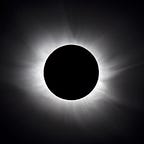The ultimate guide to solar eclipse glasses
Special solar eclipse glasses are required to look at the sun, but those inside the Path of Totality ONLY must remember to remove them during Totality
Are you confused about when and when not to wear solar eclipse glasses on August 21?
Witnessing a solar eclipse can dangerous, and it’s no surprise that campsites, local authorities and charities will be handing-out eclipses glasses. They’re easy enough to wear, but don’t treat them like sunglasses; they can be hooked over the ears like sunglasses, but always hold them in front of your eyes with both hands to stop them slipping.
This is what NASA says:
The only safe way to look directly at the un-eclipsed or partially eclipsed sun is through special-purpose solar filters, such as “eclipse glasses” or hand-held solar viewers. Homemade filters or ordinary sunglasses, even very dark ones, are not safe for looking at the sun. To date four manufacturers have certified that their eclipse glasses and handheld solar viewers meet the ISO 12312–2 international standard for such products: Rainbow Symphony, American Paper Optics, Thousand Oaks Optical, and TSE 17. Always inspect your solar filter before use; if scratched or damaged, discard it. Read and follow any instructions printed on or packaged with the filter. Always supervise children using solar filters.
Here’s what you MUST do if you’re watching the (partial) eclipse from OUTSIDE the Path of Totality:
1 — Wear your solar eclipse glasses the whole time.
2 — That’s it.
Here’s what you MUST do if you’re watching the Total Solar Eclipse from INSIDE the Path of Totality:
1 — Wear your solar eclipse glasses for the initial partial eclipse phase.
2 — When the beads of light disappear and it goes dark, remove your solar eclipse glasses for the two-minute Totality (seriously, REMOVE them!).
3 — When the Diamond Ring appears about two minutes later, put your solar eclipse glasses back on for the receding partial eclipse phase (or, more likely, talk to everyone around you and crack open the champagne).
It’s very important to wear solar eclipse glasses while watching a partial eclipse, which is what precedes and follows a Total Solar Eclipse. Look at the Sun directly and you risk damaging your eyes.
BUT … Totality is perfectly safe to look at with your naked eye.
A total solar eclipse is about as bright as the Full Moon — and just as safe to look at.
So do not let teachers, parents and overly conservative people stop you from watching the few minutes of Totality, which is both safe and spectacular. There WILL be a great deal of effort by ill-informed adults to prevent school kids from watching this eclipse. To deny someone a glimpse of something so stunning is criminal. It will happen, but don’t allow it to happen to you.
Check any existing, old solar eclipse glasses you have for pinholes, even scratches; you don’t want any damaging light getting through during the partial eclipse phases. If in doubt, buy some new ones from:
www.rainbowsymphony.com/eclipse-glasses
REMEMBER: Solar eclipse glasses — or hand-held solar viewers — must meet the ISO 12312–2 international standard. Homemade filters or ordinary sunglasses, even very dark ones, are not safe for looking at the un-eclipsed or partially eclipsed Sun.
Thinking of camping? — Check out our ebook: USA Eclipse 2017 Camping & RV Guide: More than 100 festivals, campsites & RV Parks for the Total Solar Eclipse of August 21, 2017
PS: Thanks for taking the time out to read my post! If you like my blog, please …
1) Leave a comment or press ❤ to recommend it
2) Share it with your network
3) Follow me for future posts (@thenexteclipse)
5) Spend a few dollars on one of my USA eclipse travel guides
6) Visit www.WhenIsTheNextEclipse.com
